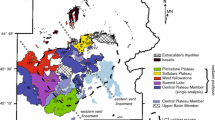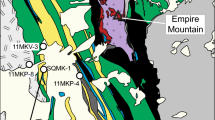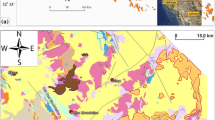Abstract
Highly evolved rhyolite glass plus near-solidus mineral assemblages in voluminous, dacitic, crystal-rich ignimbrites provide an opportunity to evaluate the late magmatic evolution of granodiorite batholiths. This study reports laser-ablation ICP-MS analyses of trace element concentrations in feldspars, hornblende, biotite, titanite, zircon, magnetite, and interstitial glass of the crystal-rich Fish Canyon Tuff. The high-silica rhyolite glass is characterized by relatively high concentrations of feldspar-compatible elements (e.g., 100 ppm Sr and 500 ppm Ba) and low concentrations of Y (<7 ppm) and HREE (~1 ppm Yb), hence high LREE/HREE (Ce/Yb >40) compared to many well-studied high-silica rhyolite glasses and whole-rock compositions. Most minerals record some trace element heterogeneities, with, in particular, one large hornblende phenocryst showing four- to six-fold core-to-rim increases in Sr and Ba coupled with a decrease in Sc. The depletions of Y and HREE in the Fish Canyon glass relative to the whole-rock composition (concentrations in glass ~30% of those in whole rocks) reflect late crystallization of phases wherein these elements were compatible. As garnet is not stable at the low-P conditions at which the Fish Canyon magma crystallized, we show that a combination of modally abundant hornblende (~4%) + titanite (~0.5–1%) and the highly polymerized nature of the rhyolitic liquid led to Y and HREE depletions in melt. Relatively high Sr and Ba contents in glass and rimward Sr and Ba increases in euhedral, concentrically zoned hornblende suggest partial feldspar dissolution and a late release of these elements to the melt as hornblende was crystallizing, in agreement with textural evidence for feldspar (and quartz) resorption. Both observations are consistent with thermal rejuvenation of the magma body prior to eruption, during which the proportion of melt increased via feldspar and quartz dissolution, even as hydrous and accessory phases were crystallizing. Sr/Y in Fish Canyon glass (13–18) is lower than the typical “adakitic” value (>40), confirming that high Sr/Y is a reliable indicator of high-pressure magma generation and/or differentiation wherein garnet is implicated.




Similar content being viewed by others
References
Bachmann O, Bergantz GW (2003) Rejuvenation of the Fish Canyon magma body: a window into the evolution of large-volume silicic magma systems. Geology 31(9):789–792
Bachmann O, Dungan MA (2002) Temperature-induced Al-zoning in hornblendes of the Fish Canyon magma, Colorado. Am Mineral 87:1062–1076
Bachmann O, Dungan MA, Lipman PW (2000) Voluminous lava-like precursor to a major ash-flow tuff: low-column pyroclastic eruption of the Pagosa Peak Dacite, San Juan Volcanic field, Colorado. J Volcanol Geotherm Res 98:153–171
Bachmann O, Dungan MA, Lipman PW (2002) The Fish Canyon magma body, San Juan volcanic field, Colorado: rejuvenation and eruption of an upper crustal batholith. J Petrol 43(8):1469–1503
Bachmann O, Oberli F, Dungan MA, Meier M, Fischer H (submitted to Chemical Geology) 40 Ar/39 Ar and U-Pb dating of the Fish Canyon magmatic system, San Juan Volcanic field, Colorado: evidence for an extended crystallization history
Bateman PC, Chappell BW (1979) Crystallization, fractionation, and solidification of the Tuolumne Intrusive Series, Yosemite National Park, California. Geol Soc Am Bull 90:465–482
Bea F (1996) Residence of REE, Y, Th, and U in granites and crustal protoliths; implications for the chemistry of crustal melts. J Petrol 37:521–552
Blundy J, Wood B (2003) Partitioning of trace elements between crystals and melts. Earth Planet Sci Lett 210(3–4):383–397
Bottazi P, Tiepolo M, Vannucci R, Zanetti A, Brumm R, Foley SF, Oberti R (1999) Distinct site preferences for heavy and light REE in amphibole and the prediction of Amph/L DREE. Contrib Mineral Petrol 137:36–45
Deer WA, Howie RA, Zussman J (1992) An introduction to the rock-forming minerals, 2nd edn. Longman Group Ltd, New York, p 698
Defant MJ, Drummond MS (1990) Derivation of some modern arc magmas by melting of young subducted lithosphere. Nature 347:662–665
Della Ventura G, Bellatrecia F, Williams CT (1999) Zr- and LREE-rich titanite from Tre Croci, Vico Volcanic complex, (Latium, Italy). Mineral Mag 63:123–136
Devine JD, Rutherford MJ, Norton GE, Young SR (2003) Magma storage region processes inferred from geochemistry of Fe–Ti oxides in andesitic magma, Soufrière Hills volcano, Montserrat, WI. J Petrol 44(8):1375–1400
Drummond MS, Defant MJ (1990) A model for trondhjemite–tonalite–dacite genesis and crustal growth via slab melting: Archean to Modern comparison. J Geophys Res 95:21503–21521
Frey FA, Chappell BW, Stephen DR (1978) Fractionation of rare-earth elements in the Tuolumne Intrusive Series. Geology 6:239–242
Garrison JM, Davidson JP (2003) Dubious case for slab melting in the Northern volcanic zone of the Andes. Geology 31:565–568
Hildreth W (1981) Gradients in silicic magma chambers: implications for lithospheric magmatism. J Geophys Res 86(B11):10153–10192
Hildreth W, Halliday AN, Christiansen RL (1991) Isotopic and chemical evidence concerning the genesis and contamination of basaltic and rhyolitic magma beneath the Yellowstone Plateau volcanic field. J Petrol 32(1):63–137
Hildreth WS, Moorbath S (1988) Crustal contributions to arc magmatism in the Andes of Central Chile. Contrib Mineral Petrol 98:455–499
Hill E, Wood BJ, Blundy JD (2000) The effect of Ca-Tschermaks component on trace element partitioning between clinopyroxene and silicate melt. Lithos 53(3–4):203–215
Irving AJ, Frey FA (1978) Distribution of trace elements between garnet megacrysts and host volcanic liquids of kimberlitic to rhyolitic composition. Geochim Cosmochim Acta 42:771–788
Irving AJ, Frey FA (1984) Trace element abundances in megacrysts and their host basalts: constraints in partition coefficients and megacryst genesis. Geochim Cosmochim Acta 48:1201–1221
Johnson M, Rutherford M (1989) Experimentally determined conditions in the Fish Canyon Tuff, Colorado, magma chamber. J Petrol 30:711–737
Justet L, Spell TL (2001) Effusive eruptions from a large silicic magma chamber: the Bearhead Rhyolite, Jemez volcanic field, NM. J Volcanol Geotherm Res 107:241–264
Klein M, Stosch H-G, Seck HA (1997) Partitioning of high field-strength and rare-earth elements between amphibole and quartz-dioritic to tonalitic melts: an experimental study. Chem Geol 138(3–4):257–271
Knesel KM, Davidson JP, Duffield WA (1999) Evolution of silicic magma through assimilation and subsequent recharge: evidence from Sr isotopes in sanidine phenocrysts, Taylor Creek Rhyolite, NM. J Petrol 40(5):773–786
Lindsay JM, Schmitt AK, Trumbull RB, De Silva SL, Siebel W, Emmermann R (2001) Magmatic evolution of the La Pacana caldera system, Central Andes, Chile: Compositional variation of two cogenetic, large-volume felsic ignimbrites. J Petrol 42(3):459–486
Lipman PW (2000) The central San Juan caldera cluster: Regional volcanic framework. In: Bethke PM, Hay RL (eds) Ancient Lake Creede: its volcano-tectonic setting, history of sedimentation, and relation of mineralization in the Creede mining district: Geol Soc Am Spec Pap 346:9–69
Lipman PW, Dungan MA, Bachmann O (1997) Comagmatic granophyric granite in the Fish Canyon Tuff, Colorado: Implications for magma-chamber processes during a large ash-flow eruption. Geology 25(10):915–918
Mahood G, Hildreth W (1983) Large partition coefficients for trace elements in high-silica rhyolites. Geochim Cosmochim Acta 47:11–30
Maughan LL, Christiansen EH, Best MG, Gromme CS, Deino AL, Tingey DG (2002) The Oligocene Lund Tuff, Great Basin, USA: a very large volume monotonous intermediate. J Volcanol Geotherm Res 113:129–157
Metz JM, Mahood GA (1991) Development of the Long Valley, California, magma chamber recorded in precaldera rhyolite lavas of Glass Mountain. Contrib Mineral Petrol 106:379–397
Murphy MD, Sparks RSJ, Barclay J, Carroll MR, Brewer TS (2000) Remobilization of andesitic magma by intrusion of mafic magma at the Soufrière Hills Volcano, Montserrat, West Indies. J Petrol 41(1):21–42
Nakada S (1991) Magmatic processes in titanite-bearing dacites, central Andes of Chile and Bolivia. Am Mineral 76:548–560
Nash WP, Crecraft HR (1985) Partition coefficients for trace elements in silicic magmas. Geochim Cosmochim Acta 49:2309–2322
Paterson BA, Stephens WE, Herd DA (1989) Zoning in granitoid accessory minerals as revealed by backscattered electron imagery. Mineral Mag 53:55–61
Ren M, Parker DF, White JC (2003) Partitioning of Sr, Rb, Y, and LREE between plagioclase and peraluminous silicic magma. Am Mineral 88:1091–1103
Rollinson H (1993) Using geochemical data: evaluation, presentation and interpretation. Longman Scientific, Harlow, 352 pp
Rutherford MJ (2002) Nature and timing of magma interaction processes in arc volcanic systems: data from rocks and from phase experiments. EOS Trans Am Geophys Union 82:47
Rutherford MJ, Devine JD (2003) Magmatic conditions and magma ascent as indicated by hornblende phase equilibria and reactions in the 1995–2002 Soufrière Hills magma. J Petrol 44(8):1433–1453
Schmitz MD, Bowring SA (2001) U–Pb zircon and titanite systematics of the Fish Canyon Tuff. An assessment of high-precision U–Pb geochronology and its application to young volcanic rocks. Geochim Cosmochim Acta 65(15):2571–2587
Sisson TW (1994) Hornblende-melt trace element partitioning measured by ion microprobe. Chem Geol 117(1–4):331–344
Tiepolo M, Oberti R, Vannucci R (2002) Trace-element incorporation in titanite: constraints from experimentally determined solid/liquid partition coefficients. Chem Geol 191(1–3):105–119
Tulloch AJ, Kimbrough DL (2003) Paired plutonic belts in convergent margins and the development of high Sr/Y magmatism: the Peninsular Ranges Batholith of California and the Median Batholith of New Zealand. Geol Soc Am Spec Pap 374:275–295
Watson EB, Harrison TM (1984) Accessory minerals and the geochemical evolution of crustal magmatic systems: a summary and prospectus of experimental approaches. Phys Earth Planet Int 35:19–30
Witt-Eickschen G, Seck HA, Mezger K, Eggins SM, Altherr R (2003) Lithospheric mantle evolution beneath the Eifel (Germany): constraints from Sr–Nd–Pb isotopes and trace element abundances in spinel peridotite and pyroxenite xenoliths. J Petrol 44:1077–1095
Wolff JA, Ramos FC, Davidson JP (1999) Sr isotope disequilibrium during differentiation of the Bandelier Tuff: constraints on the crystallization of a large rhyolitic magma chamber. Geology 27(6):495–498
Acknowledgments
As for all our papers on the Fish Canyon magmatic system, we are deeply indebted to Peter Lipman for his long-term support and collaboration. This project was supported by the Swiss NSF grant# 20–49730.96 to M.A. Dungan. We thank Mark Schmitz and an anonymous reviewer for constructive reviews of an earlier version of this manuscript and Tim Grove for efficient editorial handling.
Author information
Authors and Affiliations
Corresponding author
Additional information
T.L. Grove
Rights and permissions
About this article
Cite this article
Bachmann, O., Dungan, M.A. & Bussy, F. Insights into shallow magmatic processes in large silicic magma bodies: the trace element record in the Fish Canyon magma body, Colorado. Contrib Mineral Petrol 149, 338–349 (2005). https://doi.org/10.1007/s00410-005-0653-z
Received:
Accepted:
Published:
Issue Date:
DOI: https://doi.org/10.1007/s00410-005-0653-z




